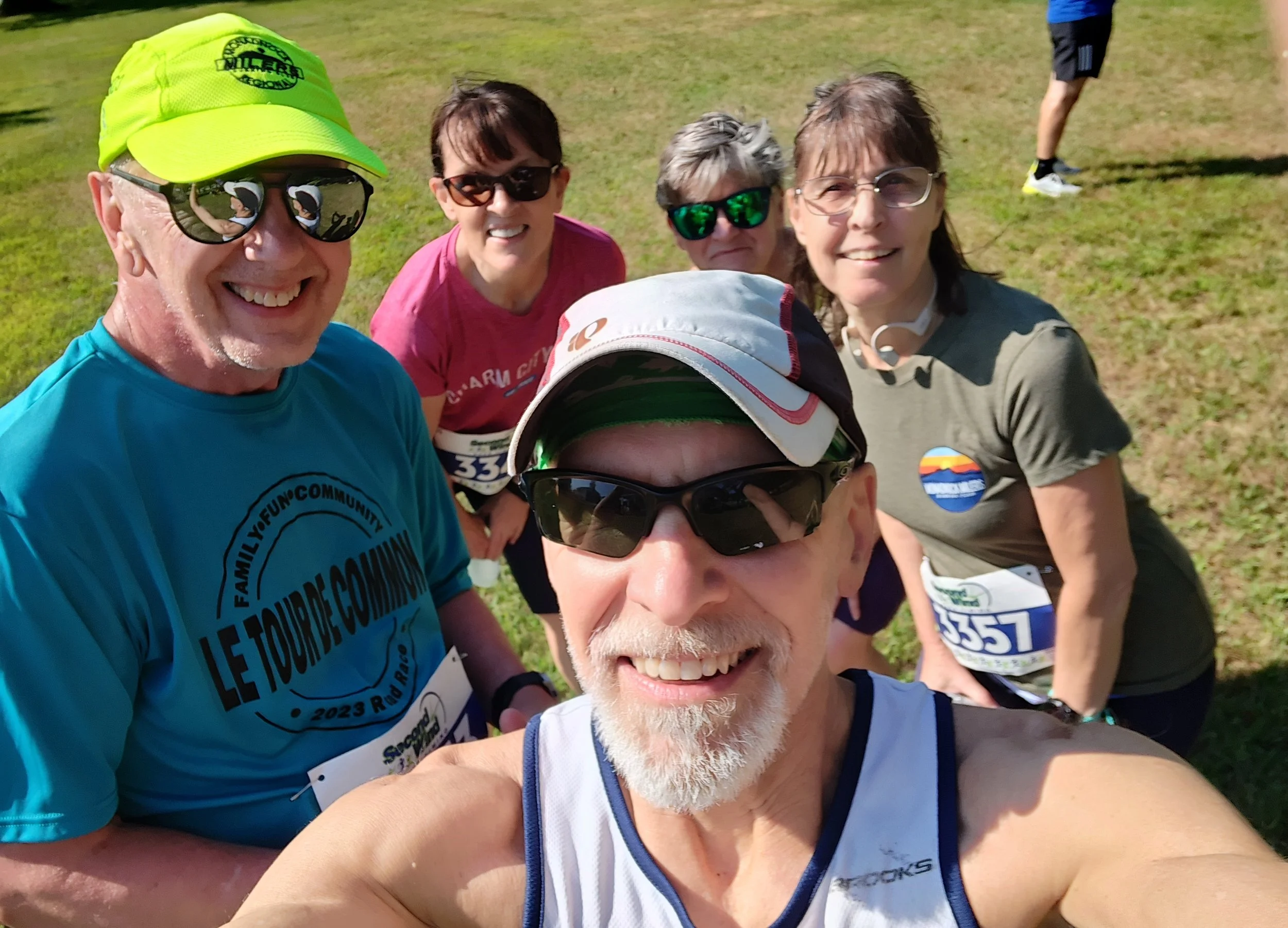Who We Are
The Monadnock Regional Milers are made up of members from towns all over the Monadnock area and beyond! In addition to our “running members,” we are also grateful to have a fantastic group of local Sponsors rounding out “who we are.”
“Who We Are” is a place you can find Member Bios as well as other stories related to our community members!
August/September Virtual Wednesday Night Workouts
August 5th CONT 200s
CONT 200’s, my “bread and butter” workout
10 x 200 meters continuously with 200 meter recovery
10 continuously run 200 meter repeats, at goal 5K race pace, with a recovery jog of 200 meters, starting with a recovery 200 as well.
Want more? 10 x 200 CONT w/200m R10 minutes easy recovery running10 x 200 CONT w/ 200 m R
August 12th 10 lap Time Trial
10 lap time trial, fitness test, tempo work
10 Lap Time Trial, 3 min on, 3 R
10 laps run uptempo (by effort), 3 minutes quick, 3 minutes recovery, until ten laps have been covered
August 19th 5x1000 CVs
CV 1000’s are 1000 meter repeats at a pace between your tempo pace and race pace. They stimulate your ability to move lactate without creating the type of oxygen debt that can extend the length of time for recovery. While quality work, it helps insure you don’t “go to the well” in a workout by running race pace but gets most of the benefits of running that fast.
August 26th 30-30
30-30 is a run where after you’ve warmed up, you run sets of 30 seconds “uptempo” followed by 30 seconds of recovery, usually in sets of 10, 12 all the way up to 20 if someone’s looking to amp it up.
September 2nd Quarters Mad
(change of speed work, mental focus)
6x
Each training group flips a total of three coins to determine the length of the repeat for the evening. Three heads means three laps for that repeat. Two heads would mean two laps and one head would mean one lap. Each training group would follow this scenario until they’ve flipped the coins six times. Once your six sets are done, the workout is over. As some of you might have figured out, all tails means no repeats for that set and the workout just got shorter. Call it luck.
The benefit to a workout like this is that the question of the distance remains for every throw, so the workout can not be predetermined mentally before you get started. This makes an athlete more open to unpredictable situations that we encounter along the way. In addition to that, the speed at which the workout is conducted is going to differ depending on which of the three distances your training group ends up with for the various repeats. This workout tends to be tougher than you think!
September 9th 600 cutdowns
5K/10K workout
600 meters @ pace/400 meters recovery
500 meters @ pace/ 300 meters recovery
400 meters @ pace/ 200 meters recovery
300 meters @ pace/ 100 meters recovery
2 x 200 meters @ pace/ 100 meters recovery
4 x 100 meters @ pace/ 100 meters recovery
September 16th CONT 200s
CONT 200’s, my “bread and butter” workout 10 x 200 meters continuously with 200 meter recovery
10 continuously run 200 meter repeats, at goal 5K race pace, with a recovery jog of 200 meters, starting with a recovery 200 as well.
Want more? 10 x 200 CONT w/200m R10 minutes easy recovery running10 x 200 CONT w/ 200 m R
September 23rd 10 lap Time Trial
10 Lap Time Trial, 3 min on, 3 R
10 laps run uptempo (by effort), 3 minutes quick, 3 minutes recovery, until ten laps have been covered
September 30th Negative split 40/50
40 minute negative split run, tempo work
40 minute negative split run
Want more?
Same as above or 50 minutes
July Virtual Wednesday Night Workouts
July 1st 30-30
30-30 is a run where after you’ve warmed up, you run sets of 30 seconds “uptempo” followed by 30 seconds of recovery, usually in sets of 10, 12 all the way up to 20 if someone’s looking to amp it up.
July 8th 6x800 CVs
CV 800’s are 800 meter repeats at a pace between your tempo pace and race pace. They stimulate your ability to move lactate without creating the type of oxygen debt that can extend the length of time for recovery. While quality work, it helps insure you don’t “go to the well” in a workout by running race pace but gets most of the benefits of running that fast.
July 15th 300/200
300/200, Medium pace work300 meters “at pace”, with 200 meters of recovery running
6x / 7x / 8x
Want more?
10x / 11x/ 12x
July 22 Hills
The aim for hills is to run with good form up the hill, to run aggressively. Hills are speed work in disguise. Hills beg for greater knee lift, a higher oxygen demand, and a greater need for efficiency. With my high school runners we do a hill session at least once a week from the beginning until just before the end of the season. Hills build strength as well as help prevent injuries by reducing the stress on the joints while accelerating the heart rate. Traditional speed work can strain ligaments, tendons and joints, especially in older athletes where hills tend to moderate the intensity level with the help of gravity. Also hills make you strong so when you encounter one during a race, while it might not be enjoyable, you can relish the fact that others around you hurt more than you because of it!
1x/2x/3x
July 29th 500/300
500/300, Medium distance pace work500 meters @ pace/ 300 meters R, 3x/4x/5x
500 meters (1 ¼ laps) run at race pace with 300 meters (3/4 lap) recovery jog, three sets or four sets or five sets
Want more? 500 meters pace / 300 meters R, 5x/6x/7x
Virtual Wednesday Night Workouts
[Sean Radcliffe: Below Coach Mike Smith is continuing with the summer “Wednesday Night Workouts” that you can do on the day and place you choose, hence “Virtual Wednesday Night Workouts”. The MRM are not sponsoring any track workouts at ConVal HS.]
Now that spring is here (fingers crossed!) we will begin virtual Wednesday Night Workouts (WNW.) For years we’ve been ripping laps on the CV oval pursuing the goal of getting faster. Workouts are fashioned after the ones I’ve developed for my cross country teams which has worked out pretty well for us.
However with that said, there’s never been a straight interpretation of what my high school kids do (as we aren’t HS kids anymore!) and while they say what’s good for the goose, as I age I’m realizing that it might not exactly be good for the gander. The things we could get away with back then are a little different than they are now. So this year I’m looking to “add in” a little more tempo based effort work rather than as much “at pace” effort work. Tempo work is the backbone of any endurance program and while tempo is an effort and not a time, there are ways to “standardize” it a little using the track and the watch.
Which brings me to another point, watches. An athlete certainly can run without one, and by chance, they could even get faster. But if you really want to utilize WNWs to improve your 5K times, a watch is going to be the tool for the trade. Doesn’t need to be fancy, just needs a stopwatch with a split button. Time isn’t the end all, be all, but if you’re looking to improve, unless you just intrinsically know what “tempo pace” and “race pace” is, the watch is the best way for you to standardize the workout.
Do these workouts on a quiet stretch of road, on the track somewhere solo or appropriately distanced, or in your backyard if you can. We’ll get things going with our first workout on June 3rd with what I call my “bread and butter” workout, sets of ten 200 meter repeats at 5K goal pace with a 200 meter active running recovery. Ten too easy?, stack another set. Still too easy, add another!
[Sean Radcliffe: Here is a link to Coach Smiths’ vWNW track workout descriptions]

